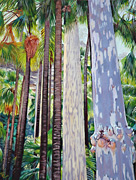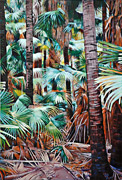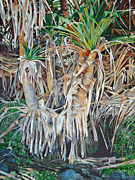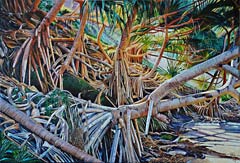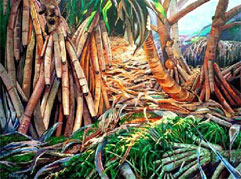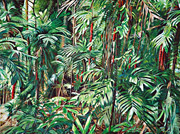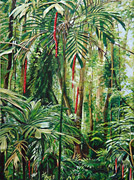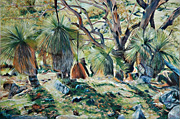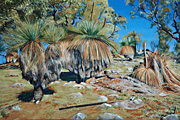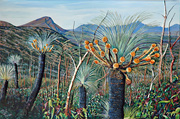Monocot Groves series
There are several major divisions in the classification of vegetation which broadly reflect their evolutionary history. Gymnosperms consist of conifers and their allies and have "naked" seeds. Angiosperms evolved after Gymnosperms and characteristically have seeds with protective "coats". There are two groups within Angiosperms: 1) Monocotyledons and 2) Dicotyledons. This division is based on the number of cotyledons, or seed leaves, produced upon sprouting.
Most Australian native trees, such as the Eucalypts, are Dicot Angiosperms although there are some important native Gymnosperms such as Wollemi Pine, the Araucarias, and Callitris pines. In contrast, most Monocots are grass-like vegetation.
There are however, several groups of Monocots that have developed a tree form. The most common are the Palms. The 2 most common native palms on the east coast of Australia are Cabbage-tree Palm (Livistona australis) and Bangalow Palm (Archontophoenix cunninghamiana). They are both tall trees (up to 20m) that can grow in small groves or in association with rainforest or wet sclerophyll forest. Pandanus Palms are commonly found in groves adjacent to coastal beaches from mid-NSW north.
While Palms have woody stems and leaves, they have distinctive differences from both Gymnosperm and Dicot Trees. Most obvious are the large feather or fan-shaped leaves. Stems are thin and cylindrical, often with lateral scars from leaf stems. Monocots have no cambium layer within the stem to produced secondary thickening cells so they produce few branches and thus have a markedly different architecture to Dicots or Gymnosperms. These features produce distinct differences in light/shadow, leaf patterns and stem form in contrast to the more familiar Australian Eucalypt forests.
Pandanus Palms produce branches and aerial roots. Both are simple cylindrical forms that look weird in contrast to Dicot trees.
Walking Stick Palms (Linospadix monostachya) are a common understory of sub-tropical rainforests in northern NSW. They are small shrubs, with a thin cylindrical stem with characteristic banding (apparently used for walking stick canes) and an umbrella thatch of large leaves. A distinctive feature of these leaves is the thick inverted "V" of the terminal pinnae. The two paintings of Walking Stick Palms from Dorrigo National Park rainforest show the bright red fruit that hang on long spikes from the palm's canopy. These red hanging fruit produce a striking contrast to the overwhelming dominance of green in these rainforests.
From rainforests to harsher environments. One distinctive Australian monocot that grows and survives on poor soils is the Grasstree (Xanthorrhea sp. ). These monocots mostly consist of a squat stem with a crown of long, rigid, grass-like leaves. The stem is comprised of accumulated leaf bases, that have secondary thickening, and therefore grow very slowly. Branches occur occasionally in some species and have the strange form similar to Pandanus Palms. A long cylindical spike extending above the leaf-crown supports a covering of small flowers.
Grasstrees can survive on very harsh soils. Honeysuckle Ridge, north of Tumut NSW, is part of the Coolac Serpentinite; a set of rocks-types that are derived from ancient oceanic crust. Because of its parent material origin, serpentinite soils can have high concentrations of heavy metals (nickel and chromium) and other chemical imbalances that limit the vegetation that can grow in them. Grasstrees are one of these "serpentine-adapted" species and make them a characteristic feature of Honeysuckle Ridge.
The "grass" leaf canopy of Grasstrees produce a distinctive green-live erect halo above a desiccated skirt of dead leaves (reminisant of a hula dress) surrounding the stem. This vegetative pattern is presented in contrast to the more familiar canopy of eucalypt trees. Upon death, a Grasstree rapidly disintegrates into a pile of stem bracts and dead leaves.
Western Australian is famous for it's diverse native flora, including many species and genera indigenous to that State. Kingia is one such genus with a single species (Kingia australis) only found in WA. While Kingia and the Grasstrees (Xanthorrhea) have a remarkable physical similarity, they are unrelated. Their flower stalks are however, distinctly different.
Both genera are similar in their ability to regenerate after wildfire.


